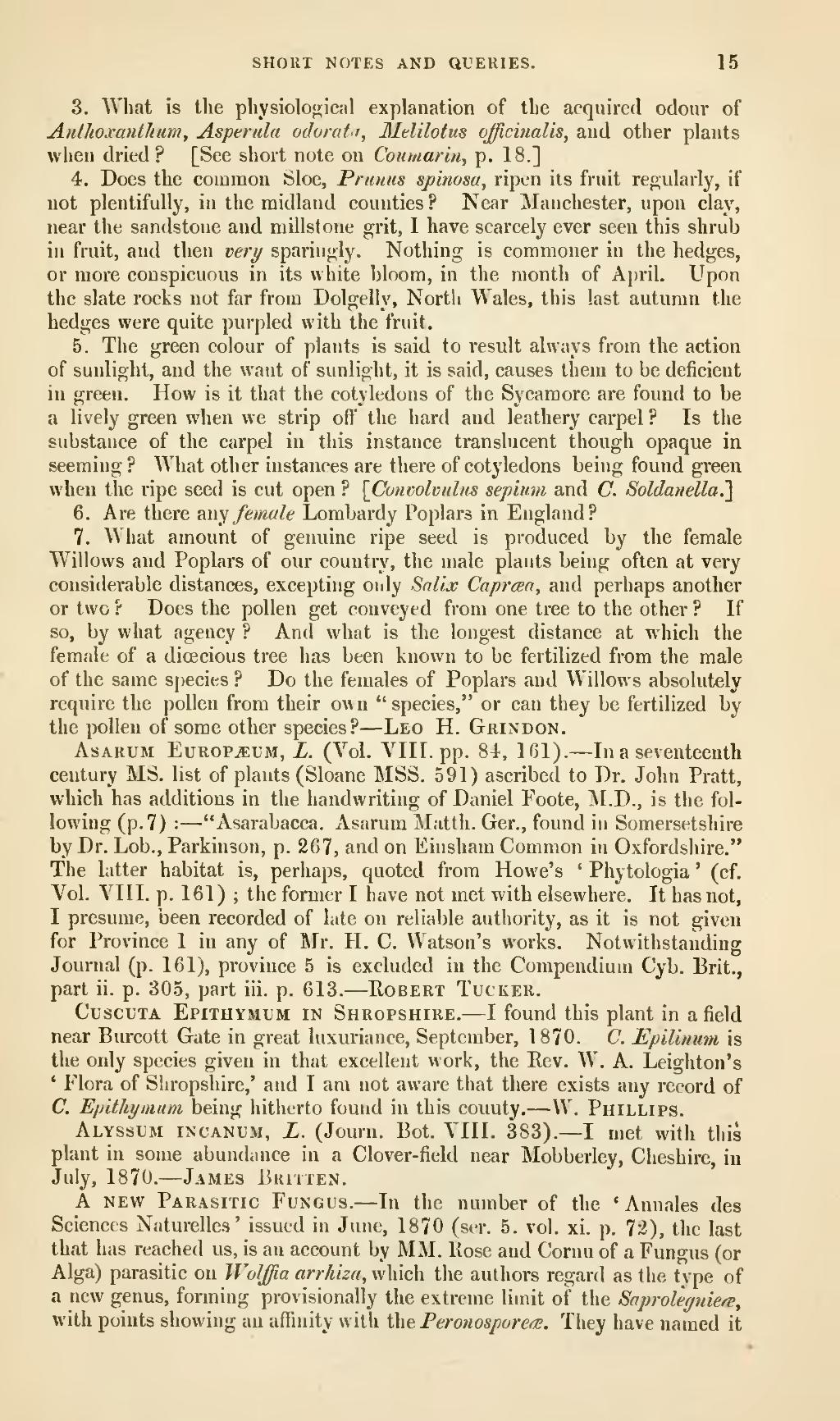SHOUT NOTES AND QUERIES. 15
3. What is the pliysioloj;ic;il explanation of the acquired odour of Anthoxantlium, Aspenda udorat<f, Mtlilotus officinalis, and other plants when dried ? [See short note on Coumarin, p. 18.]
4. Does the common Sloe, Prunus spinom, ripen its fruit regularly, if not plentifully, in the midland counties ? Near Manchester, upon clay, near the sandstone and millstone grit, 1 have scarcely ever seen this shrub in fruit, and then very sparingly. Nothing is commoner in the hedges, or more conspicuous in its white bloom, in the month of April. Upon the slate rocks not far from Dolgelly, North Wales, this last autumn the hedges were quite purpled with the fruit.
5. The green colour of plants is said to result always from the action of sunlight, and the want of sunlight, it is said, causes them to be deficient in green. How is it that the cotyledons of the Sycamore are found to be a lively green when we strip off the hard and leathery carpel ? Is the substance of the carpel in this instance translucent though opaque in seeming ? What other instances are there of cotyledons being found green when the ripe seed is cut open ? [Convolvidiis sepium and C. Soldanella.}
6. Are there any female Lombardy Poplars in England?
7. What amount of genuine ripe seed is produced by the female Willows and Poplars of our country, the male plants being often at very considerable distances, excepting only Snlix Caprcea, and perhaps another or two ? Does the pollen get conveyed from one tree to the other ? If so, by what agency ? And what is the longest distance at which the female of a dioecious tree has been known to be fertilized from the male of the same species ? Do the females of Poplars and Willows absolutely require the pollen from their ow n " species," or can they be fertilized by the pollen of some other species? — Leo H. Grindon.
AsARUM Europium, L. (Vol. VIII. pp. 81, 161). — In a seventeenth century MS. list of plants (Sloane MSS. 591) ascribed to Dr. John Pratt, which has additions in the handwriting of Daniel Eoote, M.D., is the fol- lowing (p. 7) : — "Asarabacca. Asarum Mattli. Ger., found in Somersetshire by Dr. Lob., Parkinson, p. 2G7, and on Einsham Common in Oxfordshire." The latter habitat is, perhaps, quoted from Howe's ' Phytologia ' (cf. Vol. VIII. p. 161) ; the former I have not met with elsewhere. It has not, I presume, been recorded of late on reliable authority, as it is not given for Province 1 in any of Mr. H. C. Watson's works. Notwithstanding Journal (p. 161), province 5 is excluded in the Compendium Cyb. Brit., part ii. p. 305, part iii. p. 613. — Robert Tucker.
CuscuTA Epithymum in Shropshire. — I found this plant in afield near Burcott Gate in great luxuriance, September, 1870. C. Epilinum is the ordy species given in that excellent work, the Rev. W. A. Leighton's ' Flora of Shropshire,' and I am not aware that there exists any record of C. Epithymum being hitherto found in this county. — W. Phillips.
Alyssum incanum, L. (Journ. Bot. VIII. 383). — I met with this plant in some abundance in a Clover-field near Mobberley, Cheshire, in July, 1870. — James Britten.
A NEW Parasitic Fungus. — In the number of the ' Annales des Sciences Naturelles ' issued in June, 1870 (ser. 5. vol. xi. p. 72), the last that has reached us, is an account by MM. Rose and Cornu of a Fungus (or Alga) parasitic on Wolffia arrhiza, which the authors regard as the type of a new genus, forming provisionally the extreme limit of the SaproleyniefS, with points showing an affinity with the Feronosporers. They have named it
�� �
